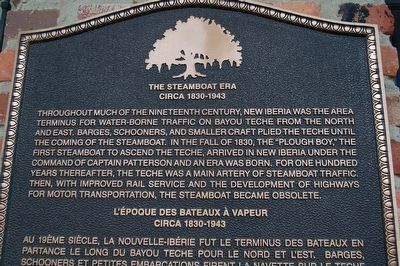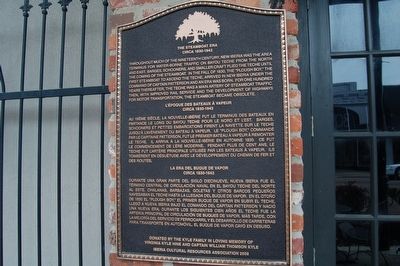New Iberia in Iberia Parish, Louisiana — The American South (West South Central)
The Steamboat Era
Circa 1830-1943
Throughout much of the nineteenth century, New Iberia was the area terminus for water-borne traffic on Bayou Teche from north and east. Barges, schooners and smaller craft plied the Teche until the coming of the steamboat. In the fall of 1830, the "Plough Boy", the first steamboat to ascend the Teche , arrived in New Iberia under the command of Captain Patterson and an era was born. For one hundred years thereafter, the Teche was a main artery of steamboat traffic. Then, with improved rail service and the development of highways for motor transportation, the steamboat became obsolete.
Virginia Kyle Hine and Captain William Thomson Kyle
Iberia Cultural Resources Association 2008
French:
circa 1830-1943
Au 19ème siècle, la Nouvelle-Ibérie fut le terminus des bateaux en partance le long du Bayou Teche pour le nord et l’est. Barges, schooners et petites embarcations firent la navette sur le Teche jusqu’à l’avènement du bateau a vapeur. Le “Plough Bo,” commandé par le Captaine Patterson, fut le premier bateau à vapeur à remonter le Teche. Il arriva à Nouvelle-Ibérie en automne 1830. Ce fut commencement de à l’ère moderne. Pendant plus de cent ans, le Teche fut l’artère principale utilisée par les bateaux à vapeur. Ils tombèrent en désuétude avec le développement du chemin de fer et des routes.
Spanish:
circa 1830-1943
Erected 2008 by Iberia Cultural Resources Association.
Topics. This historical marker is listed in these topic lists: Industry & Commerce • Waterways & Vessels. A significant historical year for this entry is 1830.
Location. 30° 0.355′ N, 91° 49.093′ W. Marker is in New Iberia, Louisiana, in Iberia Parish. Marker is at the intersection of East Main Street (State Highway 182) and North Iberia Street, on the right when traveling west on East Main Street. Touch for map. Marker is at or near this postal address: 101 E Main St, New Iberia LA 70560, United States of America. Touch for directions.
Other nearby markers. At least 8 other markers are within walking distance of this marker. The Gouguenheim Building (a few steps from this marker); Kathleen Babineaux Blanco (within shouting distance of this marker); Louisiana's First Black Female Physician Dr. Emma Wakefield~Paillet (within shouting distance of this marker); Provost's Café and Bar/Clementine Fine Dining and Spirits (within shouting distance of this marker); Wormser's Department Store (within shouting distance of this marker); Church Alley (within shouting distance of this marker); The Great Fire (within shouting distance of this marker); a different marker also named Church Alley (about 300 feet away, measured in a direct line). Touch for a list and map of all markers in New Iberia.
More about this marker. One of twenty-one trilingual historical markers (Spanish, French and English) located throughout New Iberia.
Credits. This page was last revised on March 31, 2024. It was originally submitted on August 12, 2015. This page has been viewed 495 times since then and 26 times this year. Photos: 1, 2. submitted on August 12, 2015. • Bernard Fisher was the editor who published this page.
Editor’s want-list for this marker. A wide photo of the marker and the surrounding area in context. • Can you help?

